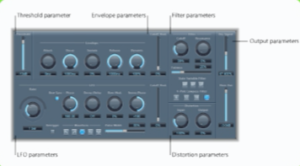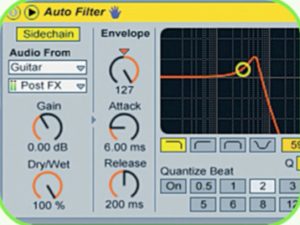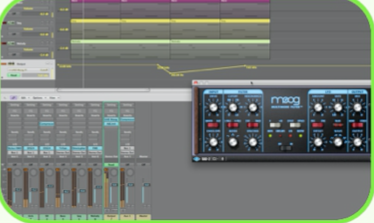Filtering
Filtering
There are many ways to access the power of filtering, but probably the easiest is to use a plug-in. Logic’s AutoFilter is a good example of Emagic’s creative approach to plug-in design. On the surface it appears to be a typical low-pass filter, not unlike those found on many synthesizers and samplers. However, look a little deeper and you’ll find some quite intriguing functionality. What makes AutoFilter particularly special is the way in which it’s capable of responding dynamically to the sound being processed (or a sidechain input – but more on that later). Put another way, the filter’s characteristics can be modulated by the level of sound being fed into the input. Filters work best when they’re moving, or being modulated in some way; a static filter is rarely as exciting. Any additional means of (automatically) controlling a filter is a welcome addition to an already powerful tool.

The Auto Factor
But what is it that puts the Auto into the AutoFilter? The answer lies in the envelope and LFO sections, and this is where things start to get really interesting. What makes the AutoFilter different to the majority of other filter plug-ins is its ability to dynamically track the level of the input signal and then modulate its own cut-off point accordingly. Rather than you turning the cut-off up and down, the AutoFilter can do it on your behalf. This can sound great on drums where the percussive hits in the loop can be translated into a rhythmic pulsing of the filter. Put another way, it turns the filter into a threshold-based processor, similar to other processes such as compression and gating. The envelope section works in conjunction with the threshold. When the input exceeds the threshold, the envelope generator is triggered to create a characteristic ‘blip’ in the sound. Changing the qualities of the envelope and the amount of modulation will change the characteristic of the effect from subtle to extreme, all in response to the original sound.

Most sequencer packages now come with their own filter plug-ins, but you might want to try some other third party plug-ins such as the Antares Filter, Prosoniq Freeware North Pole, GRM Tools and some ensembles in Reaktor 5.
Low-Pass Filter
As its name suggests, this passes the lower frequencies while filtering out the higher ones. The point at which it starts filtering is the cut-off point determined by the cut-off control. Its general result is to reduce the high frequency
High-Pass Filter
High-pass filtering attenuates the low frequencies from a signal. These filters are terrific for emulating the sound of a tinny radio speaker or telephone. Gradually lowering the cut-off frequency returns low frequencies to the signal, giving the effect of a track morphing from thin to fat. Try this on a complete mix, either during the intro, during a breakdown, or on a fade out.
These effects can be achieved through using Logic’s Channel EQ, but also with many other hard and software products. The Logic Channel EQ is pictured below in action on the high and low-pass filters respectively
Other Filter Types
The simplest synth filter has a low-pass response with variable resonance at the cut-off point. However, there are a number of other filter types that can be useful, and we’ll look at some of them.
Band-Pass Filter
The band-pass filter passes a band of central frequencies while filtering/attenuating those above and below it. Great for isolating a narrower frequency range.
Comb Filter
The comb filter is a special form of filter: it has several notches at a certain distance, which is what it makes it look like a “comb”. It is essentially a delay with feedback, but the input signal is not passed through. Short delays are sometimes used (30 – 40 ms) to create reverb.
Resonance Parameter
The resonance control is interesting. It boosts the amplitude (that’s volume to us normal folks) of the frequencies around the cut-off point. As the resonance is increased, the boosted band becomes narrower.
Notch Filter
The notch filter works the opposite way as the band-pass filter, it filters out the frequencies in a central band, leaving only those above and below.
In Practice
Filters tend to add an electronic texture to the audio that you process and for that reason work well when you want to process acoustic audio recording (vocals, guitars, drums etc.) with electronic elements.
Just running audio through a synth-type filter can be fun. They can be used this way for a creative EQ type of effect, particularly when you experiment with higher resonance settings. But things get more interesting when you manipulate a filter in real-time. An envelope is often used to do this, and the trigger that this envelope requires can be derived from the audio signal itself.

Remember that the envelope can also be routed to control a filter’s resonance for extra variety. What’s more, other modulation sources can be used in place of an envelope generator. LFOs can be fun in this role, either used free- running or with their rates synced to tempo; envelope followers can also be used.
The latter could control the filter cut-off frequency according to the level of the input signal. In other words: the higher the input signal level, the higher the filter frequency (or vice versa if that’s how you want to set it – typically this is the VCF in an analog synth). The sound you get is a bit like an auto-wah, depending on how you set it.



